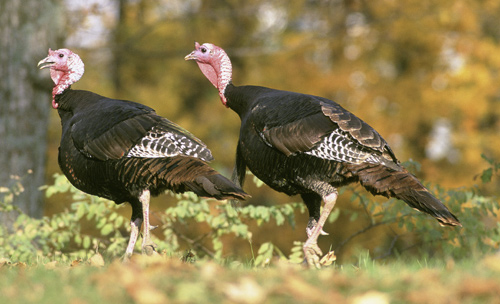Wild turkeys are the birds from which our domestic turkeys were bred. They are large, brown birds. The males have featherless red heads with small wattles, spurs over an inch long on their legs and an up to foot long "beard" resembling hair that sprouts from their chest. Males have irridescent feathers. Females are a lighter brown than males, have featherless gray to light blue heads and lack spurs. Very occassionally a female will grow a beard. The adult males can weigh between 15 and 25 pounds, females weigh 8 to 12 pounds.
Wild turkeys cluck often to one another. Feeding turkeys may "purr" contentedly and a "put" sound is a warning call. During breeding, males gobble.
There are 5 subspecies of wild turkey that live throughout the continental US. The subspecies found in Connecticut lives from southern Maine to nothern Florida, west to eastern Texas and north to North Dakota. It is the largest and most widespread subspecies.
Loss of habitat from forest clearing combined with several harsh winters erradicated wild turkeys from Connecticut by the early 1800s. As farming in Connecticut decreased over the last century, reforestation has occurred, but turkeys weren't successfully reintroduced until wild turkeys in other areas were relocated to this state through trapping. 356 captured wild turkeys were placed at 18 sites from 1975 to 1992. All towns in Connecticut now have wild turkey populations.
Wild turkeys like shady woodlands and fields near forests. They can live in residential areas when enough food and cover is available. They are fond of habitat containing oaks as they like acorns.
Wild turkeys can run up to 25 mph. They only fly short distances but can fly up to 35 mph. They spend most of their time walking on the ground but fly up into trees to roost overnight. Wild turkeys like to take dust baths and use ant hills, dry soil or dead vegetation as bathing wallows. They are active during the day.
Turkeys forage on the ground and eat nuts, seeds, fruits, corn, and insects. A major winter food source for wild turkeys are acorns. They must scratch through snow to find food in winter, and if snow cover is heavy may be seen perched in low shrubs looking for food.
In Connecticut the breeding season for wild turkeys is in late March or early April. The males make gobbling calls and puff their feathers out and fan their tails to impress females. Normally sleek, long-legged ground birds, displaying males look more like the traditional, plump Thanksgiving icon. The males breed with as many hens as they can and the dominant male will likely father most of the eggs in his area. Hens lay 8 to 14 eggs around May and incubate them for nearly a month. Nests are depressions in the ground lined with dead leaves or grass. In late summer females with babies in tow will join with other mother turkeys and form flocks. Males usually flock with other males or travel alone. Young turkeys will remain with their mother through the winter.
